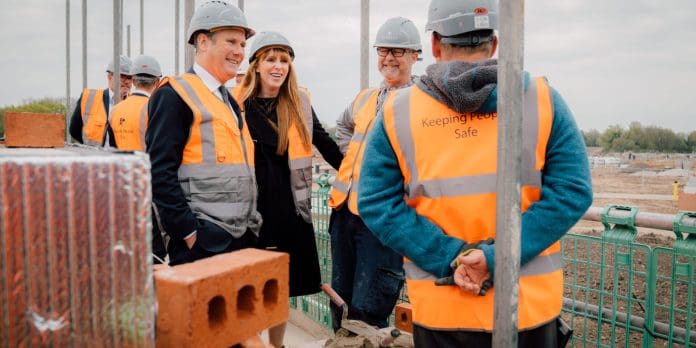Labour has published five golden rules for housebuilding, prioritising development on brownfield and ‘grey belt’ land to deliver 1.5 million homes by 2030
Keir Starmer and Angela Rayner announced the new Labour housebuilding policy on a visit to a development site on Friday 19 April, where they outlined the five golden rules that new developments will have to adhere to if Labour takes control of the government after the next election.
The party has previously declared that it will build 1.5 million new homes across the country within five years of a Labour government.
Labour’s five golden rules for housebuilding:
1. Brownfield first
Within the green belt, any brownfield land must be prioritised for development.
2. Grey belt second
Labour has created a new classification for ‘poor-quality and ugly areas’ of brownfield. This new ‘grey belt’ subset of land should be prioritised for development over nature-rich, environmentally valuable land in the green belt, and will be distinct to brownfield with a wider definition.
3. Affordable homes
Plans must target at least 50% affordable housing delivery when land is released.
4. Boost public services and infrastructure
Plans must boost public services and local infrastructure, like more school and nursery places, new health centres and GP appointments.
5. Improve genuine green spaces
Labour has ruled out building on ‘genuine nature spots’ and will require plans to include improvements to existing green spaces, making them accessible to the public, with new woodland, parks and playing fields. Plans should meet high environmental standards.
The party claims that these guiding principles will ensure that new affordable homes are built in such a way that protects natural green spaces and does not put excess pressure on public services and infrastructure.
The plans to revitalise grey belt land were praised by some
Real estate consultancy Knight Frank has identified 11,000 grey belt sites in England, estimating that they could be used to deliver between 100,000 and 200,000 new family homes.
Melanie Leech, chief executive of the British Property Federation, said: “Labour rightly identifies the potential of ‘Grey Belt’ land to deliver new homes. This is one of a raft of planning reforms that are needed to boost housing supply, many of which are in our manifesto, ‘Building our Future’ . A lot of Green Belt land is actually very poor quality but perversely has good transport links, and it should be brought to life to provide new homes, jobs and community facilities.
“The UK desperately needs more homes and modern critical infrastructure to make the country more productive and sustainable, and today’s announcement is one of many steps needed to get us there.”
Rico Wojtulewicz, head of policy and market insight at the National Federation of Builders said: “The devil will always be in the detail, but Labour appears to understand that placemaking requires input and support from all quarters and that the housebuilder’s job is to build the homes, not control what infrastructure is required, how offsite nature links up to a new development and why a site is allocated for new homes.”
However, others argued for greater clarity and collaboration in the new Labour housebuilding policy
Victoria Hills, chief executive of the RTPI, said: “We understand we are facing a severe housing crisis, and there is an urgent need to build more homes. However, it’s also important to understand the initial purpose of the greenbelt as a land management tool. Before we begin using new terms to describe this land, we need experts, such as planners, to clearly define what we mean by green belt, grey belt, and brownfield land, and to monitor its quality.
“Expert planners will also be needed to help councils follow any new rules and definitions and use them strategically to make sure that they benefit the whole community.
“To do this effectively, we will need strategic planning. Without strategic planning across all nations, we’re planning with one hand tied behind our backs. We believe that proportionate reviews of Green Belts at a strategic level are important for them to serve their intended purpose as a policy tool for preventing urban sprawl.”

















